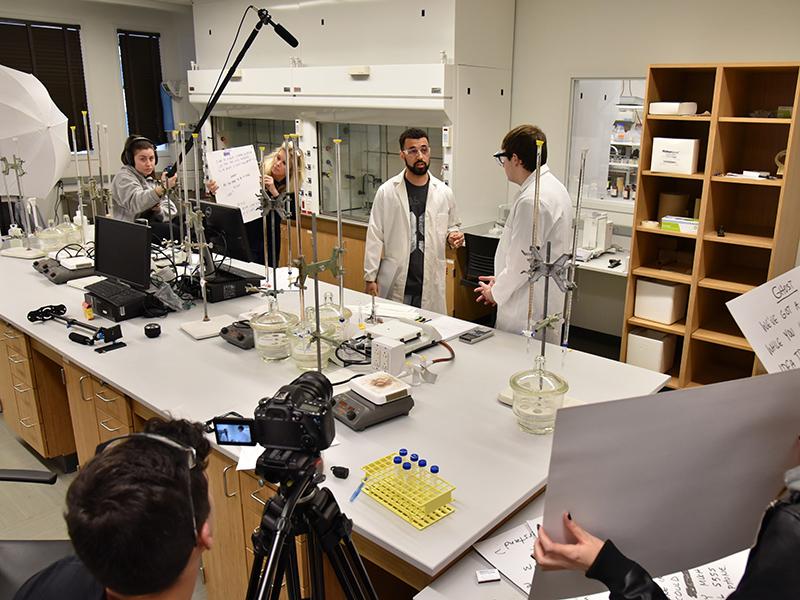Collaborative film -- Students from classes in SUNY Oswego’s creative writing, chemistry and cinema and screen studies programs work on a recent weekend shoot in the Shineman Center, part of a collaborative effort to develop a series of short films on laboratory safety.
A spirit of collaboration led to SUNY Oswego’s creative writing, chemistry and cinema and screen studies programs working together to create a series of short films on laboratory safety.
A 2017 College of Liberal Arts and Sciences Humanities Collaboratory workshop -- where faculty members could speak with each other about their cross-discipline research and project needs -- served as the catalyst.
The chemistry department was in need of new materials to present to incoming students pertaining to lab safety, and instead of a PowerPoint lecture, the idea of student-made short films emerged as Juliet Aires Giglio, an assistant professor of cinema and screen studies, spoke with Thomas Brown of the chemistry faculty.
Giglio’s advanced screenwriting class got to work producing a total of eight scripts, each demonstrating a different practice of lab safety, but with a twist.
They created the concept of having a ghost of a fictitious student teach these techniques. According to the script, the ghost’s death decades ago was caused by not following the proper procedures and he is stuck in purgatory until he knows that no other students will make the same mistakes as him.
“To see a story go from idea to production has been amazing,” said junior dual broadcasting and creative writing major Timothy Brenner. “I’m excited for students to see the finished project and have fun learning.”
Brenner was the mind behind the idea of the ghost teaching the lab safety techniques. “I wanted to do something out of the box and different from what other safety videos have done,” he said.
He also worked on the script that discussed the proper handling of hazardous wastes. Seeing the transformation of the scripts gave students a great foundation to work with and build upon, said Brenner.
Industrial films such as these are not common for students to be working on, but are something they will likely face as they start their career.
“Saying I can also do instructional videos is a whole other level,” said senior cinema and screen studies major Victoria Jayne, makeup artist and one of the film editors on set. “This will be great to add to my portfolio.”
After a number of revisions, the scripts went to Joshua Adams’ location filmmaking class, which went through a lengthy pre-production stage to solidify actors, props, crews and schedules. In this case, Giglio acted as the agency hiring all the positions, with the chemistry department as the client.
‘Win-win’
The chemistry department is receiving a useful safety product out of this and “the students are getting real life experience,” said Giglio. “It's a win-win.”
The filming and editing for this project is done out of class, a time commitment for both the students and faculty, but worth the experience that comes out of it. This project gives students the chance to interact on set in a realistic way: There are numerous crew members, script writers and actors all in one place.
To ensure accuracy, Brown was present during filming in Shineman Center where his input on the scripts and actions of the actors was an important factor in making these films usable. When it comes to industrial films, there are often strict rules that need to be followed, in this case for safety reasons.
“I have a much deeper respect for what I see on TV now; it’s like an army,” said Brown.
Four different crews are responsible for filming two scripts each, giving students the chance to take on different roles as well.
“We work to give (students) as much experience in different types of filmmaking as we can,” said Adams, assistant professor of cinema and screen studies. “It is good to give the students hard parameters that might not be as fun, but it gives them the background they need.”
The editing for these films will run through the summer, when some students will receive independent study credits for their work. The project is scheduled for completion by the beginning of the fall semester.
The Humanities Collaboratory is a College of Liberal Arts and Sciences initiative that aims to build bridges across academic disciplines, skillsets and resources, as well as to infuse digital initiatives into the traditional arts and sciences.




